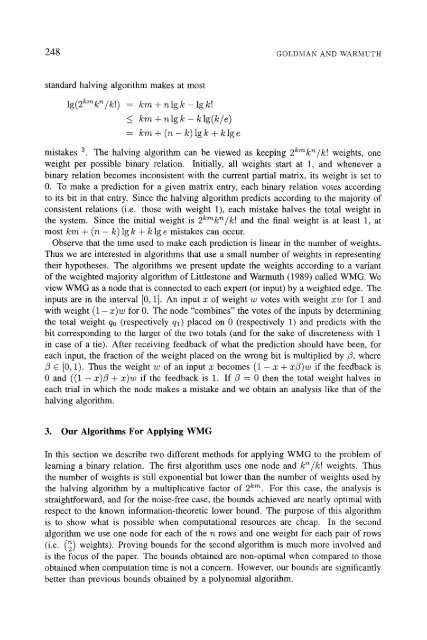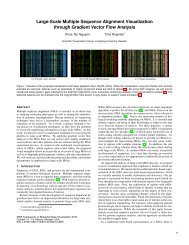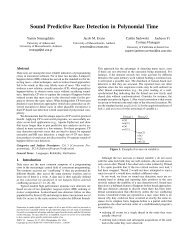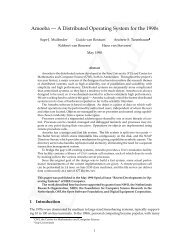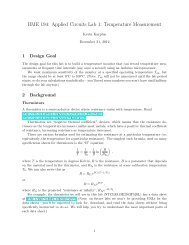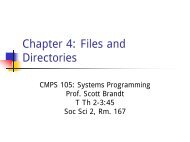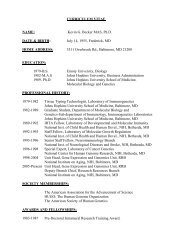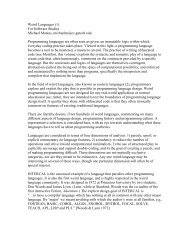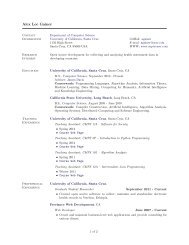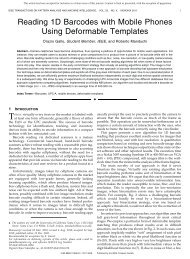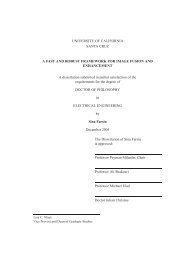Learning binary relations using weighted majority voting
Learning binary relations using weighted majority voting
Learning binary relations using weighted majority voting
You also want an ePaper? Increase the reach of your titles
YUMPU automatically turns print PDFs into web optimized ePapers that Google loves.
248 GOLDMAN AND WARMUTH<br />
standard halving algorithm makes at most<br />
lg(2Æ~k~/k!) = km + nlgk- Igk!<br />
_< km + ~ lg k - k lg(Æ/~)<br />
= km+(n-k) lgk+klge<br />
mistakes 3. The halving algorithm can be viewed as keeping 2kmkn/k! weights, one<br />
weight per possible <strong>binary</strong> relation. Initially, all weights start at 1, and whenever a<br />
<strong>binary</strong> relation becomes inconsistent with the current partial matrix, its weight is set to<br />
0. To make a prediction for a given matrix entry, each <strong>binary</strong> relation votes according<br />
to its bit in that entry. Since the halving algorithm predicts according to the <strong>majority</strong> of<br />
consistent <strong>relations</strong> (i.e. those with weight 1), each mistake halves the total weight in<br />
the system. Since the initial weight is 2kmk'~/k[ and the final weight is at least 1, at<br />
most km + (n - k) lg k + k lg e mistakes can occur.<br />
Observe that the time used to make each prediction is linear in the number of weights.<br />
Thus we are interested in algorithms that use a small number of weights in representing<br />
their hypotheses. The algorithms we present update the weights according to a variant<br />
of the <strong>weighted</strong> <strong>majority</strong> algorithm of Littlestone and Warmuth (1989) called WMG. We<br />
view WMG as a node that is connected to each expert (or input) by a <strong>weighted</strong> edge. The<br />
inputs are in the interval [0, 1]. An input x of weight w votes with weight xw for 1 and<br />
with weight (1 -x)w for 0. The node "combines" the votes of the inputs by determining<br />
the total weight qo (respectively qa) placed on 0 (respectively 1) and predicts with the<br />
bit corresponding to the larger of the two totals (and for the sake of discreteness with 1<br />
in case of a tie). After receiving feedback of what the prediction should have been, for<br />
each input, the fraction of the weight placed on the wrong bit is multiplied by/3, where<br />
/3 C [0, 1). Thus the weight w of an input x becomes (1 - x + x/3)w if the feedback is<br />
0 and ((1 - x)/3 + x)w if the feedback is 1. If/3 = 0 then the total weight halves in<br />
each trial in which the node makes a mistake and we obtain an analysis like that of the<br />
halving algorithm.<br />
3. Our Algorithms For Applying WMG<br />
In this section we describe two different methods for applying WMG to the problem of<br />
learning a <strong>binary</strong> relation. The first algorithm uses one node and km/k! weights. Thus<br />
the number of weights is still exponential but lower than the number of weights used by<br />
the halving algorithm by a multiplicative factor of 2 km. For this case, the analysis is<br />
straighfforward, and for the noise-free case, the bounds achieved are nearly optimal with<br />
respect to the known information-theoretic lower bound. The purpose of this algorithm<br />
is to show what is possible when computational resources are cheap. In the second<br />
algorithm we use one hode for each of the n rows and one weight for each pair of rows<br />
(i.e. (~) weights). Proving bounds for the second algorithm is much more involved and<br />
is the focus of the paper. The bounds obtained are non-optimal when compared to those<br />
obtained when computation time is not a concern. However, our bounds are significantly<br />
better than previous bounds obtained by a polynomial algorithm.


